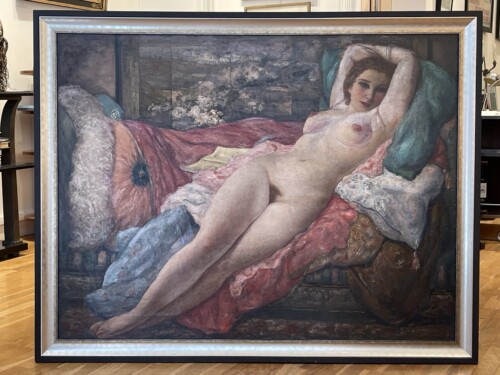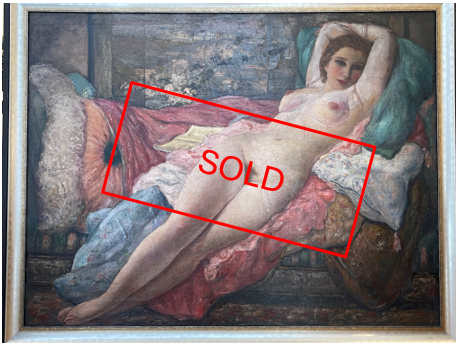Ce tableau nommé Nina, présente dans un intérieur une jeune femme posant. L’artiste réalise ici, une de ses spécialités, qui lui a valu les louanges des critiques, un nu féminin. Ce tableau démontre la virtuosité de l’artiste dans l’art du raccourci déjà souligné par ses contemporains, mais aussi son étude approfondie de la représentation des corps.
Cette scène est caractéristique du travail de Yasushi Tanaka. On y retrouve les influences des grands classiques de l’art occidental qu’il connaît bien, mais aussi une atmosphère orientalisante. Ce goût pour l’Orient est marqué par le paravent en arrière-plan et par la richesse des tissus et drapés colorés éminemment décoratifs.
Le cadrage de la scène est resserré, le fond est obstrué par le paravent qui empêche une ouverture de l'arrière-plan et confère à la scène un caractère intime et personnel. Nina vient poser son regard sur le nôtre, ce qui apporte un lien privilégié avec le spectateur.
Cette œuvre a été réalisée en 1928, et elle a été présentée au Salon de la Société Nationale des Beaux-Arts entre le 28 avril et le 10 juin 1928.
Ce tableau présente quelques craquelures, mais est dans un bon état général. C’est une huile sur toile d’origine, elle est signée en bas à droite et est titrée au dos.
Dimensions : 97 x 130 cm
Bibliographie : L’art et les artistes, Revue d’art de France et de l’Etranger, 1921, Novembre, (numéro 21), L’exposition Tanaka au Salon d’Automne
Pour plus d'informations sur l'artiste, cliquez ici
The painting titled "Nina" depicts a young woman posing in an interior. In this work, the artist shows his specialty, a female nude, for which he received critical acclaim. The painting demonstrates the artist's virtuosity in the art of foreshortening, as praised by his contemporaries.
This scene is characteristic of Yasushi Tanaka's work, featuring influences from Western art classics that he was familiar with, as well as an oriental atmosphere. The preference for the East is evident in the screen and the richness of the highly decorative fabrics and drapes.
The scene is tightly framed, with the background closed by the screen giving the scene an intimate and personal character. Nina watches directly the viewer, creating a privileged connection with him.
This artwork dates back 1928, it was displayed at the National Salon between 28th of April and 10th of June 1928.
The painting shows some craquelure but is in overall good condition. It is an oil on the original canvas, signed at the bottom left, and titled on the back.
Dimensions : 97 x 130 cm / 38 x 51.19 inches
Bibliography: L'art et les artistes, Revue d'art de France et de l'étranger, 1921, November, (issue 21), The Tanaka Exhibition at the Salon d'Automne
For more informations about the artist, please click here
-
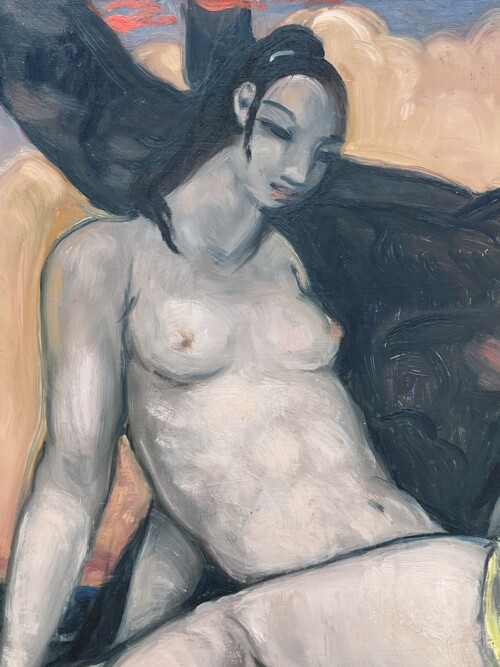
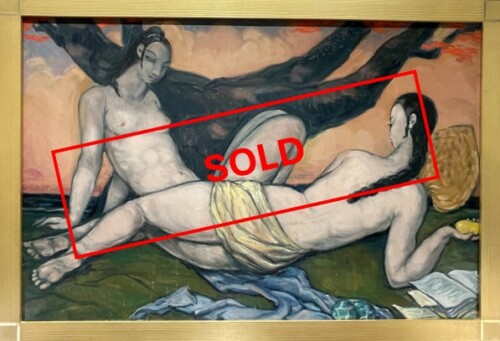 André Maire est l'un des plus célèbres « Peintres Voyageurs » français qui a beaucoup voyagé en Europe, en Afrique et en Extrême-Orient à partir de 1910, notamment en Inde, à Madagascar, au Cambodge et au Vietnam. Il a enseigné l'art de la peinture à Hanoï - Vietnam, etc. Les peintures à l'huile d'André Maire sont beaucoup plus rares que ses gouaches sur papier. • Porte le cachet de l'atelier au dos. Dimensions : H : 59 cm L : 90 cm (sans cadre) H : 62 cm L : 93 cm P : 2 cm (avec cadre) _________________________________ André Maire is one of the most famous French « Peintres Voyageurs » who travelled extensively in Europe, Africa and the Far East from 1910 in particular to India, Madagascar, Cambodgia and Vietnam. He taught the art of painting in Hanoï -Vietnam etc. Oil paintings by André Maire are a lot more scarce than his gouache on paper.
André Maire est l'un des plus célèbres « Peintres Voyageurs » français qui a beaucoup voyagé en Europe, en Afrique et en Extrême-Orient à partir de 1910, notamment en Inde, à Madagascar, au Cambodge et au Vietnam. Il a enseigné l'art de la peinture à Hanoï - Vietnam, etc. Les peintures à l'huile d'André Maire sont beaucoup plus rares que ses gouaches sur papier. • Porte le cachet de l'atelier au dos. Dimensions : H : 59 cm L : 90 cm (sans cadre) H : 62 cm L : 93 cm P : 2 cm (avec cadre) _________________________________ André Maire is one of the most famous French « Peintres Voyageurs » who travelled extensively in Europe, Africa and the Far East from 1910 in particular to India, Madagascar, Cambodgia and Vietnam. He taught the art of painting in Hanoï -Vietnam etc. Oil paintings by André Maire are a lot more scarce than his gouache on paper.- Bears the workshop stamp on the back.
-
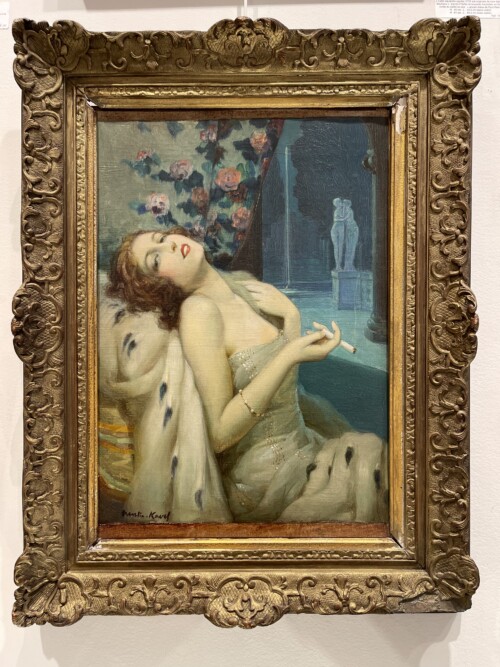
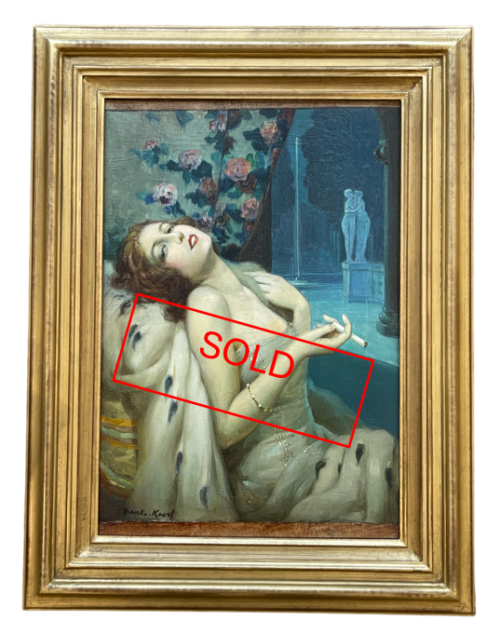 François MARTIN-KAVEL (1861-1931) Lady Astor Huile sur toile Signée : Martin-Kavel en bas à gauche, inscrit "B. Sirven Toulouse" et "Lady Astor" au revers. Années 1910 La mondaine d'origine américaine, Nancy Astor, est la première femme de l'histoire britannique à siéger au Parlement. Ses échanges avec Churchill, un misogyne notoire, sont célèbres ! Condition : Encadré. Huile sur toile, non doublée, dans une lumière rasante deux petites indentations à la naissance de ses cheveux. Deux petites taches au centre du revers et au bord supérieur central du revers de la toile. L'examen sous UV : révèle des retouches associées aux taches susmentionnées. Petit trou visible au revers (voir photos). Bon état général. Dimensions : H : 71 cm ; L : 55 cm Pour plus d’informations sur le créateur, cliquer sur son nom : François Martin-Kavel
François MARTIN-KAVEL (1861-1931) Lady Astor Huile sur toile Signée : Martin-Kavel en bas à gauche, inscrit "B. Sirven Toulouse" et "Lady Astor" au revers. Années 1910 La mondaine d'origine américaine, Nancy Astor, est la première femme de l'histoire britannique à siéger au Parlement. Ses échanges avec Churchill, un misogyne notoire, sont célèbres ! Condition : Encadré. Huile sur toile, non doublée, dans une lumière rasante deux petites indentations à la naissance de ses cheveux. Deux petites taches au centre du revers et au bord supérieur central du revers de la toile. L'examen sous UV : révèle des retouches associées aux taches susmentionnées. Petit trou visible au revers (voir photos). Bon état général. Dimensions : H : 71 cm ; L : 55 cm Pour plus d’informations sur le créateur, cliquer sur son nom : François Martin-Kavel
Lady Astor by François Martin-Kavel (1861-1931) Oil on canvas Signed : Martin-Kavel lower left, inscribed "B. Sirven Toulouse" and "Lady Astor" on the reverse. 1910s American-born English socialite Nancy Astor was the first female MP in British history to take a seat in parliament. Her exchanges with Churchill, well known misogynist, are famous! Condition: Framed. Oil on canvas, not lined, in a raking light two minor indentations to her hairline. Two small patches to the centre reverse and upper centre edge reverse of the canvas. Examined under UV: reveals associated retouching to the aforementioned patches. Small hole visible on the reverse (see photos). Overall good condition. Dimensions : H : 71 cm ; W : 55 cm For more information : François Martin-Kavel -
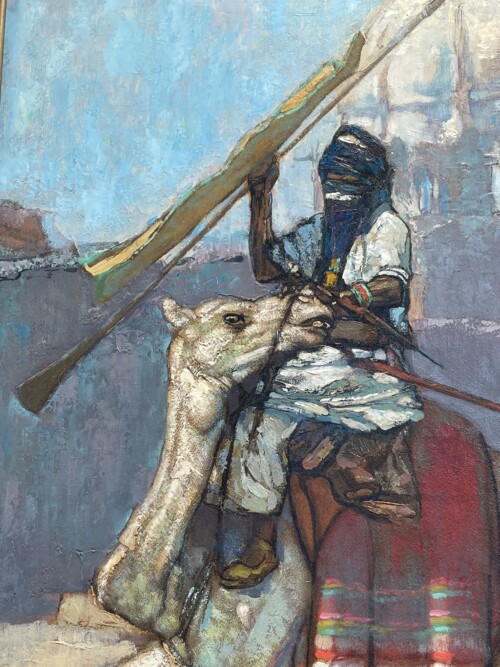
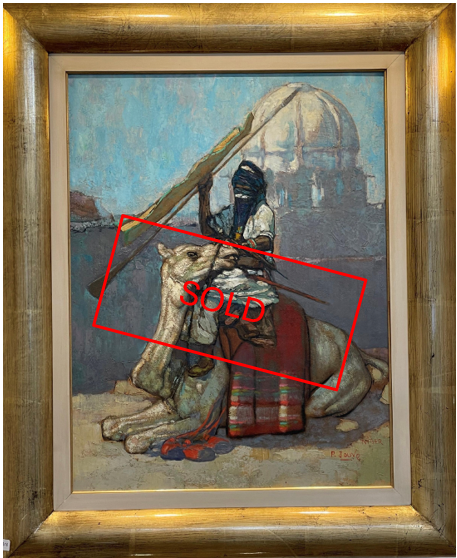 Paul JOUVE (1878-1973) : "Touareg Et Méhari Baraquant". Vers 1932. Cette peinture est l'une des meilleures œuvres du célèbre artiste Paul Jouve. Elle possède une documentation parfaite étant publiée dans l'ouvrage de référence par Félix Marcilhac et est vendue avec un certificat de Mr Suisse qui est l'expert de Paul Jouve. Il a été exposé dans au moins 2 expositions au cours des années 30 et 40 (1932 et 1943) - voir ci-dessous pour les détails. Il a également une parfaite origine ayant été acheté à la collection Paul Jouve et est resté dans la même famille depuis lors. Huile sur panneau (masonite) Signé et situé « Niger » en bas à droite Autocollants anciens au dos Dimensions hors cadre : hauteur : 64,5 cm, largeur. 50cm Cadre : 84 x 69 cm Bibliographie/Bibliography Paul JOUVE, vie et œuvre par Félix Marcilhac Éditions de l'Amateur - Paris 2005 Reproduit en pleine page P.207. Des expositions: - Salon de la Société Nationale des Beaux Arts Paris 1932. sous le numéro 1141 - Exposition Paul Jouve, galerie l'Art Français, 1943. 24 rue de la paix, Paris 8e, du 23 octobre au 6 novembre n° 19 Origine :Collection Paul Jouve, puis achat direct à l'artiste. Dans la même famille depuis. Pour plus d’informations sur le créateur, cliquer sur le nom : Paul JOUVE
Paul JOUVE (1878-1973) : "Touareg Et Méhari Baraquant". Vers 1932. Cette peinture est l'une des meilleures œuvres du célèbre artiste Paul Jouve. Elle possède une documentation parfaite étant publiée dans l'ouvrage de référence par Félix Marcilhac et est vendue avec un certificat de Mr Suisse qui est l'expert de Paul Jouve. Il a été exposé dans au moins 2 expositions au cours des années 30 et 40 (1932 et 1943) - voir ci-dessous pour les détails. Il a également une parfaite origine ayant été acheté à la collection Paul Jouve et est resté dans la même famille depuis lors. Huile sur panneau (masonite) Signé et situé « Niger » en bas à droite Autocollants anciens au dos Dimensions hors cadre : hauteur : 64,5 cm, largeur. 50cm Cadre : 84 x 69 cm Bibliographie/Bibliography Paul JOUVE, vie et œuvre par Félix Marcilhac Éditions de l'Amateur - Paris 2005 Reproduit en pleine page P.207. Des expositions: - Salon de la Société Nationale des Beaux Arts Paris 1932. sous le numéro 1141 - Exposition Paul Jouve, galerie l'Art Français, 1943. 24 rue de la paix, Paris 8e, du 23 octobre au 6 novembre n° 19 Origine :Collection Paul Jouve, puis achat direct à l'artiste. Dans la même famille depuis. Pour plus d’informations sur le créateur, cliquer sur le nom : Paul JOUVE
Paul JOUVE (1878-1973): "Touareg and Mehari Baraquant". Circa 1932. This painting is one of the best works of the famous artist Paul Jouve. It has a perfect documentation being published in the reference book by Félix Marcilhac and is sold with a certificate of Mr Suisse who is the expert of Paul Jouve. It was exhibited in at least 2 exhibitions during the 1930s and 1940s (1932 and 1943) - see below for details. It also has a perfect provenance having been bought from the Paul Jouve collection and has remained in the same family ever since. Oil on panel (Masonite) Signed and located "Niger" lower right Old stickers on the back Dimensions out of frame: height: 64.5 cm, width. 50cm Frame: 84 x 69 cm For more informations : : Paul JOUVE -
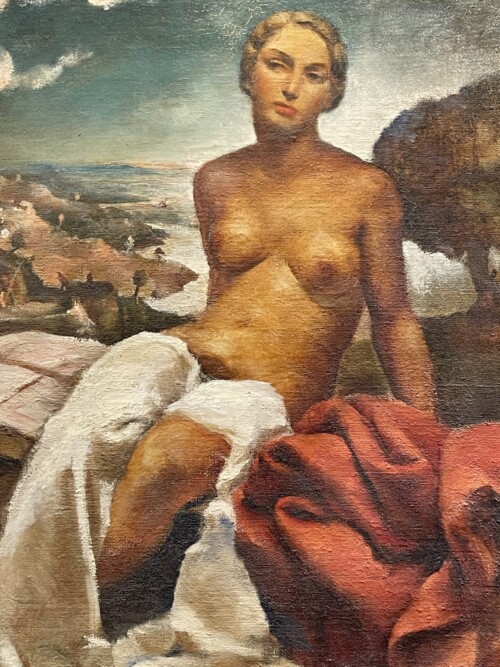
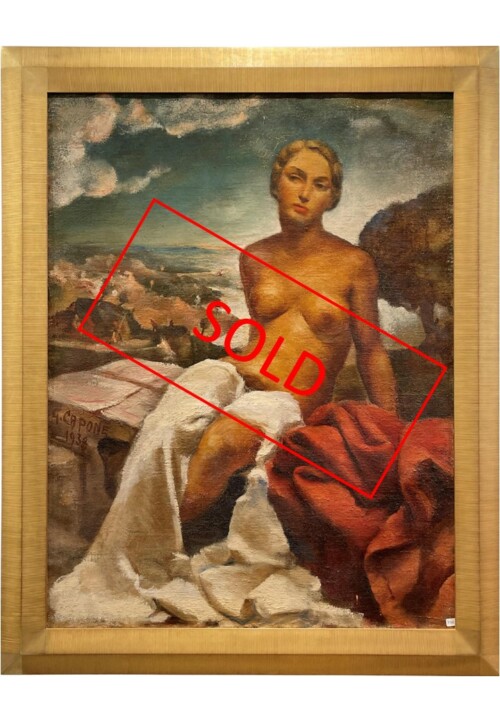 Huile sur toile (jute) de l'artiste G. Capone, datée 1938. Belle peinture néoclassique typique de la période Art-Déco. Cadre moderne. Dimensions hors cadre : 116 x 90cm ; Cadre : 108 x 135cm.
Huile sur toile (jute) de l'artiste G. Capone, datée 1938. Belle peinture néoclassique typique de la période Art-Déco. Cadre moderne. Dimensions hors cadre : 116 x 90cm ; Cadre : 108 x 135cm.
Oil on canvas (jute) by the artist G. Capone, dated 1938. Beautiful neoclassical painting typical of the Art-Deco period. Modern frame. Dimensions out of frame: 116 x 90cm; Frame: 108 x 135cm. -
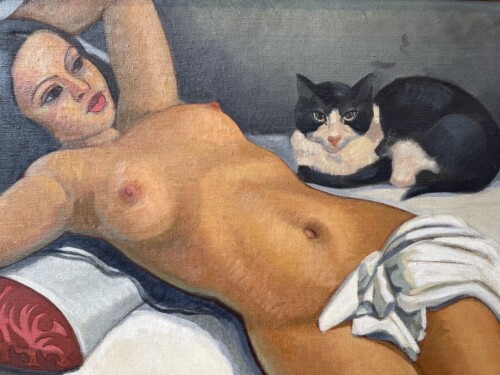
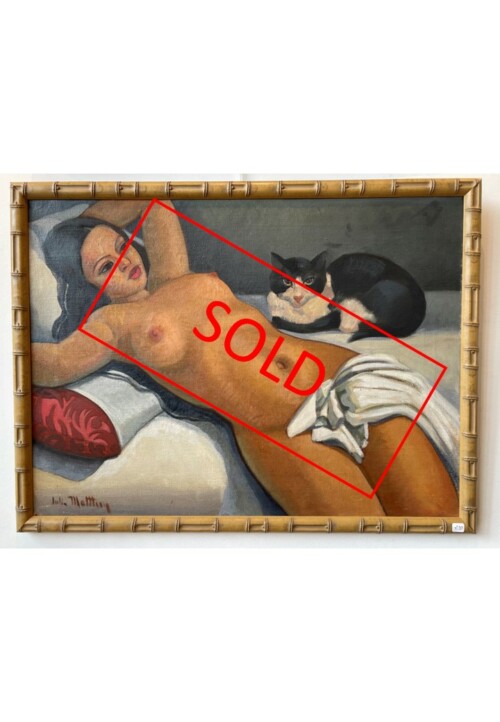 Superbe huile sur toile "Nu au chat" de Gill-Julien Matthey (1889-1956). Circa 1935-1940, période Art déco, France. Cadre en bois imitation bambou. Signé en bas à gauche. Dimensions : sans cadre : 80x60cm ; avec cadre : 86x65cm. Pour plus d’informations sur le créateur, cliquer sur le nom : Gill-Julien MATTHEY
Superbe huile sur toile "Nu au chat" de Gill-Julien Matthey (1889-1956). Circa 1935-1940, période Art déco, France. Cadre en bois imitation bambou. Signé en bas à gauche. Dimensions : sans cadre : 80x60cm ; avec cadre : 86x65cm. Pour plus d’informations sur le créateur, cliquer sur le nom : Gill-Julien MATTHEY
"Nude with Cat", Oil on Canvas by G. J. Matthey, France, Art Deco, circa 1935 Superb oil on canvas "Nude with Cat" by Gill-Julien Matthey (1889-1956). Circa 1935-1940, Art deco period, France. Wood frame imitating bamboo. Signed bottom left. Dimensions: without frame : 80x60cm frame: 86x65cm. For more informations : : Gill-Julien MATTHEY -
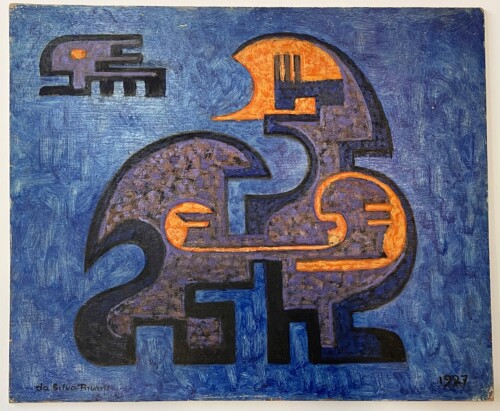
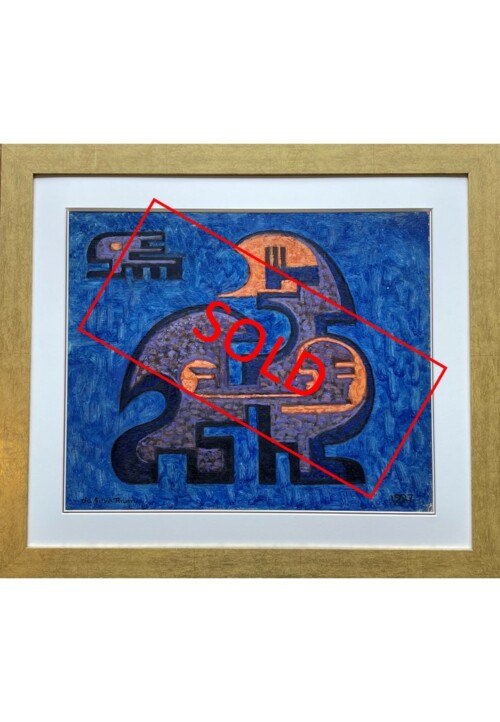 Huile sur panneau (contreplaqué) d'Ivan da Silva-Bruhns (1881-1989), titrée "Mzimou" et annotée au dos, signée en bas à gauche, datée 1927 en bas à droite. Dimensions : avec cadre : 54,5x63x2cm, sans cadre : 38x46cm. Mzimou est un terme générique désignant un esprit ou une divinité favorable dans la région du lac Tanganika à qui la population locale avait l'habitude de présenter des offrandes pour se protéger notamment des maladies. Ivan da Silva Bruhns a réinventé l'art du design de tapis dans les années 20 et l'a adapté au style art déco. Son travail est influencé par les tapis géométriques ethniques berbères (Afrique du Nord, Maroc notamment). A partir de 1925, il dirige une galerie rue de l'Odéon à Paris puis à partir de 1930 rue du Faubourg Saint-Honoré. Il réalise de nombreux tapis pour les ambassades, les monuments nationaux, les plus grands paquebots comme le Normandie, l'Ile de France etc. De la célèbre Exposition de 1925 est né un grand maître de l'art du tapis largement reconnu. De 1922 à 1936, il travaille beaucoup pour Jules Leleu et ses travaux de décoration de luxe pour des clients prestigieux. Ses huiles sont rares et très recherchées. Pour plus d’informations sur le créateur, cliquer sur le nom : Ivan DA SILVA-BRUHNS
Huile sur panneau (contreplaqué) d'Ivan da Silva-Bruhns (1881-1989), titrée "Mzimou" et annotée au dos, signée en bas à gauche, datée 1927 en bas à droite. Dimensions : avec cadre : 54,5x63x2cm, sans cadre : 38x46cm. Mzimou est un terme générique désignant un esprit ou une divinité favorable dans la région du lac Tanganika à qui la population locale avait l'habitude de présenter des offrandes pour se protéger notamment des maladies. Ivan da Silva Bruhns a réinventé l'art du design de tapis dans les années 20 et l'a adapté au style art déco. Son travail est influencé par les tapis géométriques ethniques berbères (Afrique du Nord, Maroc notamment). A partir de 1925, il dirige une galerie rue de l'Odéon à Paris puis à partir de 1930 rue du Faubourg Saint-Honoré. Il réalise de nombreux tapis pour les ambassades, les monuments nationaux, les plus grands paquebots comme le Normandie, l'Ile de France etc. De la célèbre Exposition de 1925 est né un grand maître de l'art du tapis largement reconnu. De 1922 à 1936, il travaille beaucoup pour Jules Leleu et ses travaux de décoration de luxe pour des clients prestigieux. Ses huiles sont rares et très recherchées. Pour plus d’informations sur le créateur, cliquer sur le nom : Ivan DA SILVA-BRUHNS
"Mzimou" Oil on Panel by Ivan Da Silva-Bruhns, Art Deco, 1927, France Oil on panel (plywood) by Ivan da Silva-Bruhns (1881-1989), titled "Mzimou" and annotated on the back, signed bottom left corner, dated 1927 bottom right corner. Dimensions: with frame: 54.5x63x2cm, without frame: 38x46cm. Mzimou is generic term for a favourable spirit or divinity in the lake Tanganika region to whom local population used to present offerings to get protection in particular from illnesses. Ivan da Silva Bruhns reinvented the art of carpet design in the 20's and adapted it to the art deco style. His work is influenced by the geometric berber ethnic carpets (North Africa, Morocco in particular). From 1925, he runs a gallery rue de l’Odéon in Paris then from 1930 rue du Faubourg Saint-Honoré. He produced numerous carpets for embassies, national monuments, the greatest steamers like the Normandy, the Ile de France etc. From the famous 1925 Exhibition a great master of the carpet art was born and widely recognized. From 1922 until 1936 he works a lot for Jules Leleu and his luxury decoration work for prestigious clients. His oils are rare and very much sought after. For more informations : Ivan DA SILVA-BRUHNS -
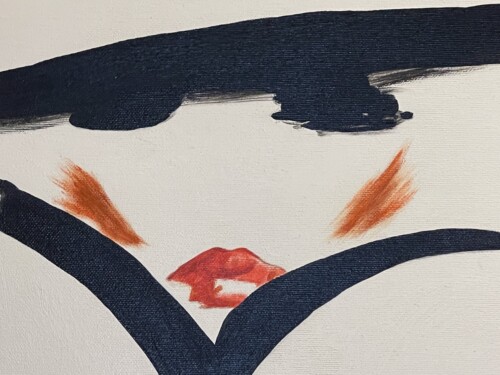
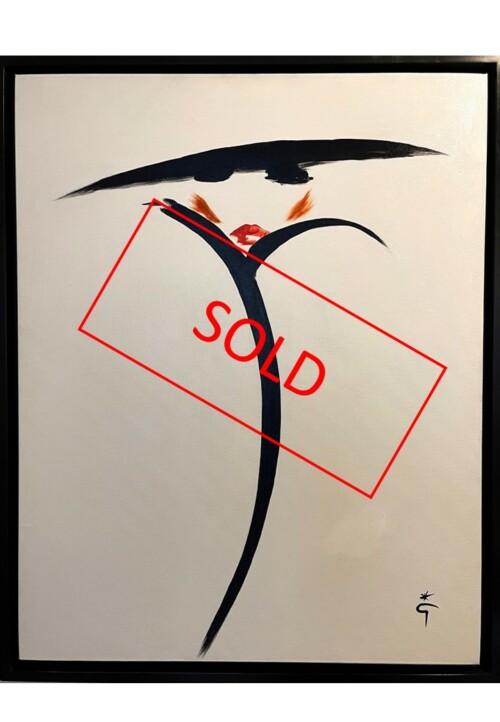 Tableau de René Gruau (1909-2004), nommé « Victoire » Acrylique sur toile Signé du monogramme, encadré dans une "boîte d'ombre" Circa 1970 Remarque : La toile a été posée sur un châssis neuf. Dimensions : sans cadre : 72,5cm x 92cm, avec cadre : 79cm x 98cm. Pour plus d’informations sur le créateur, cliquer sur le nom : René GRUAU
Tableau de René Gruau (1909-2004), nommé « Victoire » Acrylique sur toile Signé du monogramme, encadré dans une "boîte d'ombre" Circa 1970 Remarque : La toile a été posée sur un châssis neuf. Dimensions : sans cadre : 72,5cm x 92cm, avec cadre : 79cm x 98cm. Pour plus d’informations sur le créateur, cliquer sur le nom : René GRUAU
"Victoire", Painting by Gruau, France Painting by René Gruau (1909-2004), titled "Victoire" Acrilic on canvas Signed with monogram, framed in a "shadow box" Circa 1970 Note: The canvas has been put on a new chassis. Dimensions: without frame: 72.5cm x 92cm, with frame: 79cm x 98cm. For more informations : : René GRUAU -

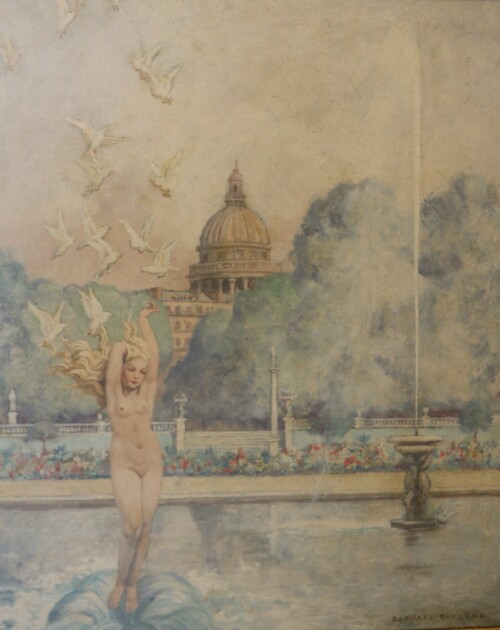 Raphael Delorme (1885-1962) fut l'un des principaux peintres de l'école de peinture bordelaise Art Déco, aux côtés de Dupas, en France dans les années 1920. Ce tableau est typique de son meilleur travail.
Raphael Delorme (1885-1962) fut l'un des principaux peintres de l'école de peinture bordelaise Art Déco, aux côtés de Dupas, en France dans les années 1920. Ce tableau est typique de son meilleur travail.- Signé en bas.
- Accompagné d'un certificat d'authenticité de l'expert Cécile Ritzenthaler.
Raphael Delorme (1885-1962) was one of the leading painter from the Art Deco Bordeaux school of painting with Dupas in France in the 1920's. This painting is typical of his best work.- Signed at the bottom.
- Accompanied by a certificate of authenticity from the expert Cecile Ritzenthaler.
-
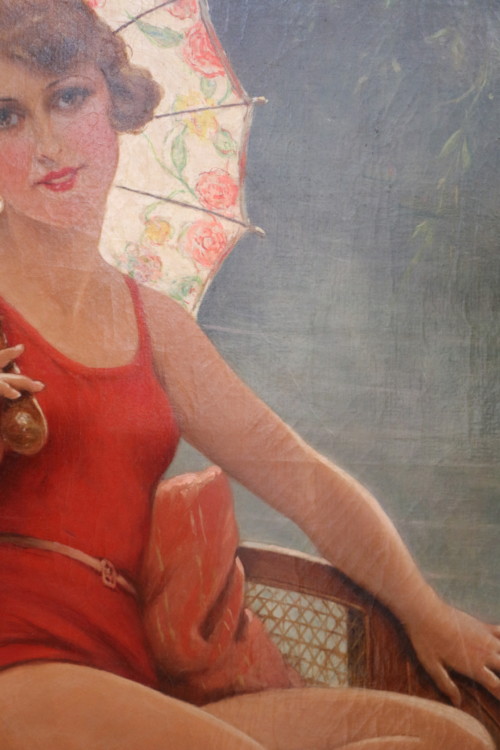
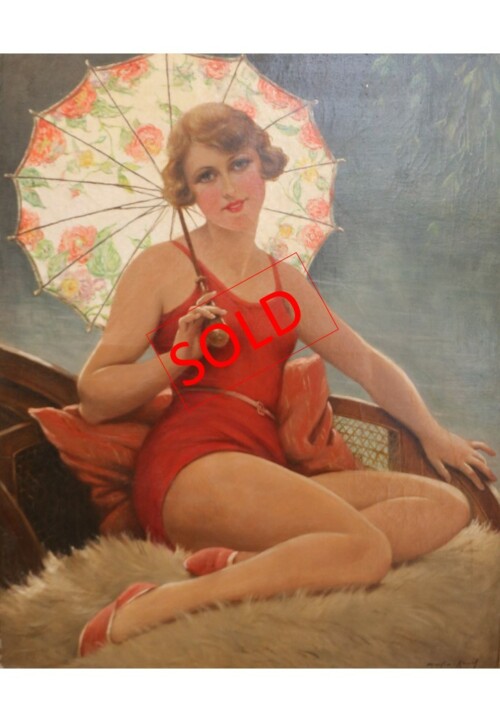 François Martin-Kavel (1861-1931) Baigneuse à l'ombrelle Huile sur toile Signée : Martin-Kavel Années 20 Dimensions : H : 81.5 cm ; L : 65.5 cm Pour plus d’informations sur le créateur, cliquer sur son nom : François Martin-Kavel
François Martin-Kavel (1861-1931) Baigneuse à l'ombrelle Huile sur toile Signée : Martin-Kavel Années 20 Dimensions : H : 81.5 cm ; L : 65.5 cm Pour plus d’informations sur le créateur, cliquer sur son nom : François Martin-Kavel
Batherwith sunshade by François Martin-Kavel (1861-1931) Oil on canvas Signed : Martin-Kavel 1920s Dimensions : H : 32.09 in ; W : 25.79 in H : 81.5 cm ; W : 65.5 cm For more information : François Martin-Kavel -
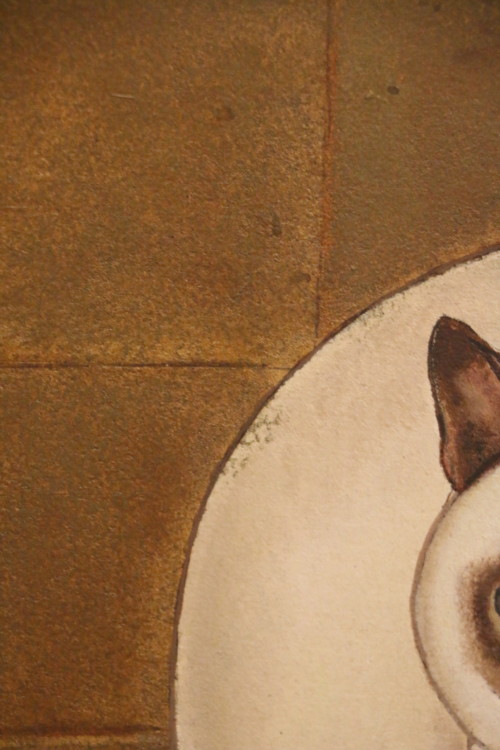
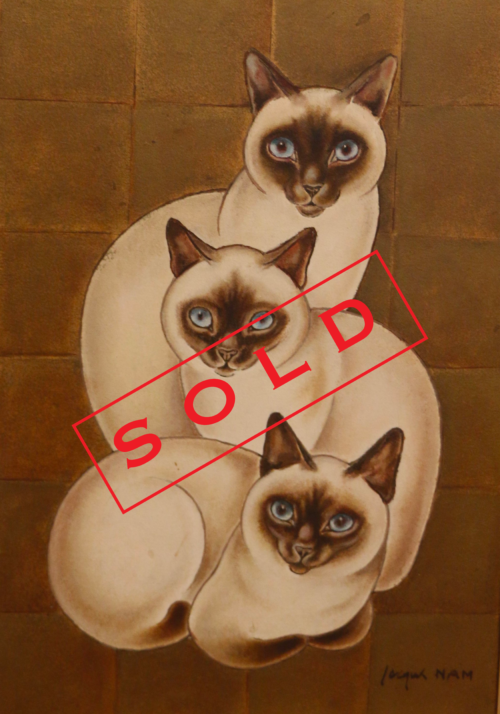 Jacques Nam (1881-1974) Trois chats siamois Huiles sur panneau Signée Année 30 Dimensions : H : 61.5 cm ; L : 48.5 cm Pour plus d’informations sur le créateur, cliquer sur son nom : Jacques Nam
Jacques Nam (1881-1974) Trois chats siamois Huiles sur panneau Signée Année 30 Dimensions : H : 61.5 cm ; L : 48.5 cm Pour plus d’informations sur le créateur, cliquer sur son nom : Jacques Nam
Three siamese cats by Jacques Nam (1881-1974) Oil on paned Signed 1930s Dimensions : H : 24.22 in ; W : 19.1 in H : 61.5 cm ; W : 48.5 cm For more informations : Jacques Nam -
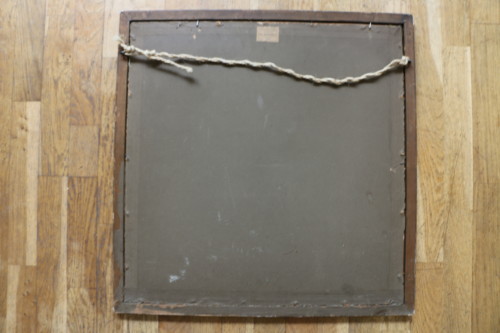
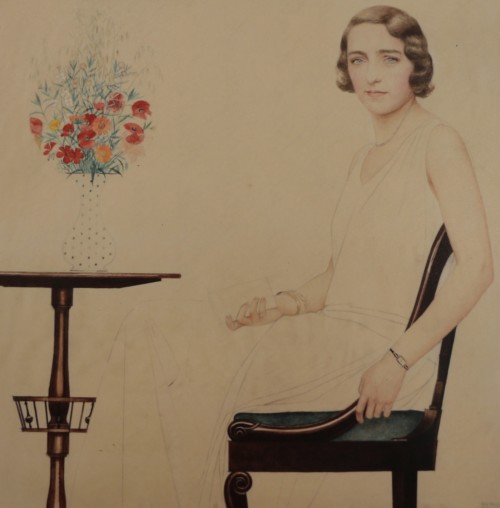 Bernard Boutet de Monvel était un peintre, sculpteur, graveur, illustrateur de mode et décorateur d'intérieur français. Bien qu'il soit d'abord connu pour ses gravures, il a gagné en notoriété pour ses peintures, en particulier ses vues hautement géométriques de New-York. En Europe et aux États-Unis, où il voyageait souvent, il est également devenu connu en tant que peintre de portraits pour des clients de la haute société.
Bernard Boutet de Monvel était un peintre, sculpteur, graveur, illustrateur de mode et décorateur d'intérieur français. Bien qu'il soit d'abord connu pour ses gravures, il a gagné en notoriété pour ses peintures, en particulier ses vues hautement géométriques de New-York. En Europe et aux États-Unis, où il voyageait souvent, il est également devenu connu en tant que peintre de portraits pour des clients de la haute société.- Aquarelle et crayon noir sur papier épais.
- Signé en bas à droite.
- Le tableau est le portrait de Mme Lise Brissaud dont la famille est décrite dans le certificat.
- Accompagné d'un certificat de Stéphane-Jacques Addade (expert à la Chambre Européenne des Experts d'Art).
Bernard Boutet de Monvel was a French painter, sculptor, engraver, fashion illustrator and interior decorator. Although first known for his etchings, he earned notability for his paintings, especially his higly geometric views of New-York. In both Europe and the United States, where he often traveled, he also became known as a portrait painter for high society clients.- Watercolor and black pencil on thick paper.
- Signed bottom right.
- The painting is the portrait of Ms Lise Brissaud whose family is described in the certificate.
- Accompanied by a certificate from Stéphane-Jacques Addade (expert at Chambre Européenne des Experts d'Art).
